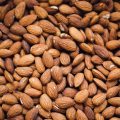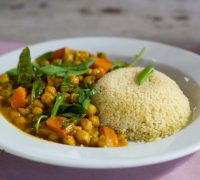When I came into this world, it quickly turned out that I was a mimosa rather than a human. This does not only apply to my personality, but also to my tummy.
At age 12 or so, my gastro-intestinal weekness was officially diagnosed by an Ayurvedic physician. (He also was the one who told me not to eat dairy products anymore, what freed me from my constant joint pain but, to my unhappiness, also ended my love relationship with yoghurt.) You can imagine that in general, my tummy is not best friends with legumes.
Still, I have decided to make legumes a regular part of my diet, and ate them almost every day during the past two (or so) weeks. This implies I have found a way to make them work for me.
You may remember that my first attempt with veganism terribly failed, and I had to take a vacation from legumes for a couple of days. But then my appetite for them came back, and I made a big batch of adzuki beans at home, which I happily devored during the subsequent days. To my surprise, nothing bad happened.
My scientifically working mind told me that I must have done something differently with those adzuki beans, compared to the legumes I had eaten before (also including adzuki beans), and this determined whether my tummy would be peaceful or go up the walls after eating them.
It deemed on me that the problem had to do with the fact that, during my first vegan experiment, I had eaten beans from the can almost every day. My first thought had been that it was the pure amount of legumes I had eaten then, because I was not used to eating them every day. Considering my happy recent indulgence, however, I have come to understand that the preparation methods actually are the crucial factor. And one thing I always do when I prepare legumes at home is to soak them overnight and then cook them for a rather long time. However, I also researched for some more boundary conditions.
A note on canned beans and lentils (read: my personal thoughts) … Those are industry products, and the industry usually does not regard for elaborate food preparation methods (more than is minimally required to make the things somewhat edible) – such procedures would slow down the production process (a little), and do not fit into a highly rationalized economy. However, these methods may be what makes the difference between pain and well-being with the person who eats the stuff, and it is definitely worth it to invest a little time (it is not even much actual operating time) and prepare your legumes yourself.
So, I am happy to share with you the results of my recent research and kitchen experimenting.
PROBLEMATIC SUBSTANCES CONTAINED IN LEGUMES
First of all, it is important to understand why legumes tend to make trouble at all. The most noticeable troubles have to do with the oligosaccharides contained in legumes. However, legumes also contain some other not-so-nice substances which you may want to get rid of.
Oligosaccharides
All legumes contain so-called oligosaccharides, complex carbohydrates built from several single sugar molecules. Oligosaccharides commonly found in legumes are raffinose, stachyose, ciceritol, and verbascose. These have to be broken down during digestion, but since humans lack a certain enzyme (α-galactosidase) required for this, the oligosaccharides pass the small intestine undigested. Only in the large intestine, they are finally broken down by bacteria. This releases gas which again causes bloating and pain.
Antinutrients
Next to the problematic oligosaccharides, legumes also contain toxid substances (antinutrients). One of those is phytic acid which inhibits mineral absorption and can foster mineral deficiencies when consumed regularly in larger amounts. Others are lectins, sugar-binding proteins which may contribute to malabsorption and lead to allergic reactions. They are especially malicious when consumed raw, leading to toxication. Therefore, legumes and particularly beans should be cooked at a boil for at least 10 minutes before cooking them as usual until soft. Please notice that preparing beans in a slow cooker may not eliminate those toxins sufficiently, if temperatures are too low!!
In general, traditional food-processing and preparation techniques like soaking, sprouting, and fermenting help to significantly reduce harmful substances contained in legumes and other plant foods, and improve the bioavailability of micronutrients.
HOW TO REDUCE OLIGOSACCHARIDE CONTENT IN LEGUMES
In reducing digestive problems with legumes, it is crucial to tackle the oligosaccharides contained in them. This can be done by the following techniques.
Selecting Legumes Wisely
Legumes differ in oligosaccharid content. In general, lentils and split peas are easier to digest, while beans and chickpeas are harder to digest. However, when using some tricks, all of them can be prepared in a tummy-friendly way.
Soaking
All dried beans and chickpeas have to be soaked in water before cooking them, but you can also soak lentils and split peas. The legumes should be covered well with water, particularly since they will grow in volume during the soaking process. Foul ones will swim at the surface so you can easily fish them out.
To also reduce antinutrient content, you can add some kind of sour substance, such as lemon juice, apple cider vinegar, whey, buttermilk, or yoghurt containing living cultures. The soaking water should not be too hot because otherwise, helpful enzymes and bacteria would be destroyed. I usually use warm water.
The longer you soak your legumes, the better, but when you soak them for a longer time, the soaking water should be changed every couple of hours. I usually soak my legumes for about 12 hours. What then happens is that some of the oligosaccharides resolve into the soaking water. After soaking, the legumes should be rinsed and drained well in a colander.
Adding Enzymes
While the human body lacks the enzyme needed for breaking down legume oligosaccharides, this enzyme is happily contained in kombu, an edible kelp used in Eastern Asian cuisine. Kombu comes in dried sheets and can be found at an Asian food store. It also provides some valuable micronutrients like iodine, potassum, calcium, and vitamins A and C. Particularly iodine is important for a happy thyroid, and people who eat no or little fish may run short in it. Edible seaweed is a nice option to get some.
Add a palm-sized piece of kombu when soaking the legumes, and another fresh one when cooking them. The enzymes in the kombu will break down the oligosaccharides during the soaking and cooking time. Also, the kombu will alkalyze the soaking and cooking water.
Kombu will get a little slimy when put into water, and cooking makes it metamorphose into a green jelly. This jelly is edible and actually healthy, but I find it a little unappealing, so I rather put the kombu into a little bag for loose leaf tea. However, you do not have to be afraid that your legumes will taste like fish when you cook them with kombu.
When the soaking is over, rinse and drain the legumes well, and use fresh water for further processing, since the soaking water contains all the stuff you want to get rid of.
Quick Boiling
Quick boiling means to cook the legumes at high heat or a few minutes. This will resolve some more oligosaccharides into the cooking water. Afterwards, rinse the legumes in a colander and set them up with fresh water. This can be done two or three times to be more effective, and will not remove significant amounts of nutrients. Then cook the legumes as usual, until soft.
When I recently told my mom about this, she said that her own mom and grandmom would always quick boil legumes three times before the regular cooking. She thought it was to get rid of the foam legumes tend to produce during cooking, but apparently, the actual meaning lies a little deeper.
Pressure Cooking
A pressure cooker is a pot with a tightly closing lid that allows for cooking under pressure and thus, at higher temperatures than usual.
I have found the suggestion to pressure cook legumes several times, but my personal experiences with it were not always fortunate. The problem is that legumes produce a lot of foam during cooking, and this foam tends to clog the exhaust valve of the pressure cooker, leading the cooker to spit slime across the stove. So, before putting your legumes into the pressure cooker, I highly recommend to give them a couple of quick boils, to reduce the foam. Pressure cooking legumes will help to improve digestability, but you also cook them in a regular saucepan. Also, pressure cooking will result in somewhat mushier legumes than regular cooking.
Long-Time Cooking
Since undercooked legumes are a bad source of tummy troubles, I like to cook them rather too long than too short. Especially with beans, I have found that it helps to cook them for a rather long time. Slow cooking is fine as well, as long as you ensure a sufficient time of high-temperature cooking in the begging, to eliminate the toxins.
Rinsing and Draining
I carefully rinse and drain my legumes again after cooking, to remove the slime and the last oligosaccharides which have resolved into the cooking water.
To finish this post in a nice way, I want to give you a short step-by-step instruction of how I make my own tummy-friendly legumes, using the example of my beloved adzuki beans.
TUMMY-FRIENDLY ADZUKI BEANS
4-5 servings
Ingredients
250 g (1/2 lb) dried adzuki beans (or other beans)
2 palm-sized pieces of dried kombu (seaweed)
1 splash of fresh lemon juice
Directions
Put the beans into a large bowl and add a generous amount of water, one piece of kombu, and a splash of lemon juice. Set aside and let soak for several hours, or overnight.
After soaking, rinse and drain the beans in a colander. Set them up with fresh water and boil them at high heat for about 5 minutes. Then, rinse and drain the beans again. Give them three quick boils in total, always using fresh water. Subsequently, cook the beans regularly in about the double amount of fresh water, together with the remaining piece of kombu, for an hour or two (or longer), covered and at medium heat. I cooked them in my big cast-iron pot and used a tea bag for the kombu.
When the cooking time is over, remove the kombu (or leave it in there, when you like that), and carefully rinse the beans again to get rid of the slime. The beans can be stored in an airtight container in the fridge, where they will stay fresh for a couple of days and are always ready for preparing a quick meal. They are wonderful and versatible for making yummy creations, like this.
What do you do with your legumes to make them friendlier to your tummy? Have you tried some of the things I have collected here, or do you use them regularly already? Can you eat legumes from the can without problems?












